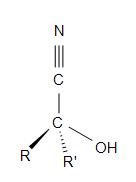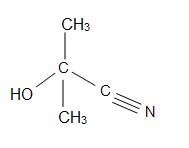Cyanohydrins

Cyanohydrins have the structural formula of R2C(OH)CN. The “R” on the formula represents an alkyl, aryl, or hydrogen. In order to form a cyanohydrin, a hydrogen cyanide adds reversibly to the carbonyl group of an organic compound thus forming a hydroxyalkanenitrile adducts (commonly known and called as cyanohydrins).
Introduction
Cyanohydrin reactions occurs when an aldehyde or ketone gets treated by a cyanide anion (such as HCN) or a nitrile forming a cyanohydrin product. This special reaction is a nucleophilic addition, where the nucleophilic CN- attacks the electrophilic carbonyl carbon on the ketone, following a protonation by HCN, thereby the cyanide anion being regenerated. This reaction is also reversible.

Cyanohydrins are also intermediates for the Strecker amino acid synthesis. The preparation of displacements of sulfite by cyanide salts are also followed under cyanohydrins.
Mechanism of Cyanohydrin Formation

Acid-catalysed hydrolysis of silylated cyanohydrins has recently been shown to give cyanohydrins instead of ketones; thus an efficient synthesis of cyanohydrins has been found which works with even highly hindered ketones.
Acetone Cyanohydrins

Acetone cyanohydrins (ACH) have the structural formula of (CH3)2C(OH)CN. It is an organic compound serves in the production of methyl methacrylate (also known as acrylic). It is classified as an extremely hazardous substance, since it rapidly decomposes when it's in contact with water. In ACH, sulfuric acid is treated to give the sulfate ester of the methacrylamid. Preparations of other cyanohydrins are also used from ACH: for HACN to Michael acceptors and for the formylation of arenas. The treatment with lithium hydride affords anhydrous lithium cyanide.

Other Cyanohydrins
Other cyanohydrins, excluding acetone cyanohydrins, are: mandelonitrile and glycolonitrile.


Mandelonitrile have a structural formula of C6H5CH(OH)CN and occur in pits of some fruits. Glycolonitrile is an organic compound with the structural formula of HOCH2CN, which is the simplest cyanohydrin that is derived by formaldehydes.
No comments:
Post a Comment